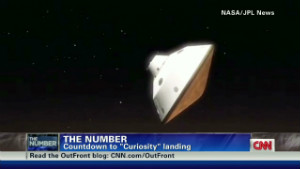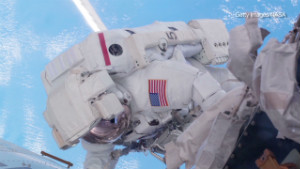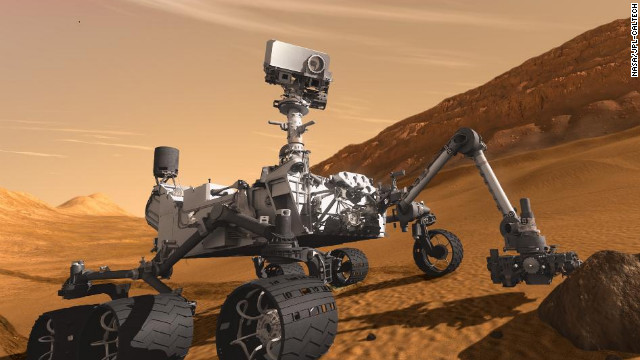Rover Curiosity just hours from Mars
STORY HIGHLIGHTS
- The dramatic landing of the SUV-sized rover is set for 1:31 a.m. ET Monday
- This landing process involves a sky crane and the world's largest supersonic parachute
- Curiosity's first stop slated to be Gale Crater, which may have once contained a lake
- The vehicle will be controlled from NASA's Jet Propulsion Laboratory
NASA's $2.6 billion
rover, Curiosity, will make its dramatic entrance into Martian territory
in a spectacle popularly known as the "seven minutes of terror."
This jaw-dropping landing process, involving a sky crane and the
world's largest supersonic parachute, allows the spacecraft carrying
Curiosity to target the landing area that scientists have meticulously
chosen.
The spacecraft is
"healthy and right on course," according to the latest update from NASA.
Curiosity has been traveling away from Earth since November 26.
The vehicle, which will
be controlled from NASA's Jet Propulsion Laboratory, has a full suite of
sophisticated tools for exploring Mars. They include 17 cameras, a
laser that can survey the composition of rocks from a distance and
instruments that can analyze samples from soil or rocks.
If all goes according to
plan, Curiosity's first stop will be Gale Crater, which may have once
contained a lake. After at least a year, the rover will arrive at Mount
Sharp, in the center of the crater. The rover will drive up the mountain
examining layers of sediment. This process is like looking at a
historical record because each layer represents an era of the planet's
history, scientists say.
 Mars, NASA's most ambitious mission
Mars, NASA's most ambitious mission
 Mars in pop culture
Mars in pop culture
 The Number: "Curiosity" Mars landing
The Number: "Curiosity" Mars landing
 Bill Nye and the 'PB&J' of space
Bill Nye and the 'PB&J' of space
The phenomenon of
sedimentary layers is remarkably similar to what is seen on Earth, in
California's Death Valley or in Montana's Glacier National Park, says
John Grotzinger, chief scientist of the Mars Science Laboratory mission.
Rocks and minerals found
on Earth are different than on Mars, but the idea of a mountain made of
layers is familiar to scientists. Unlike on Earth, however, Mars has no
plate tectonics, so the Martian layers are flat and not disrupted as
they would be on Earth. That also means that Mount Sharp was formed in a
different way than how mountains are created on Earth -- no one knows
how.
In these layers,
scientists are looking for organic molecules, which are necessary to
create life. But even if Curiosity finds them, that's not proof that
life existed -- after all, these molecules are found in bus exhaust and
meteorites, too, says Steve Squyres, part of the Mars Science Laboratory
science team.
If there aren't any
organics, that may suggest there's something on the planet destroying
these molecules, says James Wray, assistant professor of Earth and
atmospheric sciences at the Georgia Institute of Technology and
collaborator on the Curiosity science team. But if Curiosity detects
them, Wray said, that might help scientists move from asking, "Was Mars
ever habitable?" to "Did Mars actually host life?"
"A successful landing
will grant a huge breath of relief to the entire Mars science community
tonight," Wray said in an e-mail. "And it will certainly keep NASA at
the forefront of Mars exploration for at least the next few years."
Liquid water is not
something scientists expect to be apparent on Mars because the planet is
so cold and dry, Squyres said. If the planet does harbor liquid water
today, it would have to be deep below the surface, perhaps peeking out
in a few special places, but not likely to be seen by Curiosity, Squyres
said.
It's hard to know how
long ago liquid water would have been there because there's no mechanism
to date the rocks that rovers find on Mars, Squyres said.
Evidence from the
spacecraft NASA has sent to Mars so far suggests that the "warm and wet"
period on Mars lasted for the first billion years of the planet's
history.
"In order to create
life, you need both the right environmental conditions -- which includes
liquid water -- and you need the building blocks from which life is
built, which includes organics," Squyres said. The Mars Science
Laboratory is a precursor mission to sharper technology that could do
life detection, Grotzinger said.
There aren't specific
molecules that scientists are looking for with Curiosity. The attitude
is: "Let's go to an interesting place with good tools and find out
what's there," Squyres said.
NASA's Jet Propulsion
Laboratory was swarming with media this past week as scientists and
journalists prepared for signs of the rover's landing. Squyres and a
colleague told each other Thursday they were both feeling "full of hope
and optimism."
The Jet Propulsion
Laboratory wasn't the only place anxiously awaiting the rover's arrival
Sunday night. Nearly 200 people gathered at Georgia Tech in Atlanta to
hear presentations about planetary science and the search for water away
from Earth in the final hours before the landing. Other parties were
planned around the world.
Although a lot of science went into this landing process, superstition on landing night can't hurt.
It's traditional to open
up cans of peanuts and pass them around to the team at the Jet
Propulsion Laboratory responsible for overseeing the landing of the
rover, said David Oh, lead flight director for the mission, earlier this
week.
"It's always been a
lucky charm for us, and missions have always seemed to work out better
when we had the peanuts there," Oh said. "For landing this, I'll take
all the great engineering we have, and all the luck you can give us,
too."
Sunday also happens to
be the 82nd birthday of former NASA astronaut Neil Armstrong. It's hoped
the birthday will be auspicious for the landing, NASA's John Grunsfeld
said in a news conference.
Curiosity is supposed to
last for two years on Mars, but it may operate longer -- after all,
Spirit and Opportunity, which arrived on Mars in 2004, were each only
supposed to last 90 Martian days. Spirit stopped communicating with NASA
in 2010 after getting stuck in sand, and Opportunity is still going.
"You take what Mars
gives you," said Squyres, also the lead scientist on the Mars
Exploration Rover Mission, which includes Spirit and Opportunity. "If we
knew what we were going to find, it wouldn't be this much fun."

 NASA's Mars Curiosity Rover, shown in this artist's concept, is scheduled to touch down on the planet on August 6.
NASA's Mars Curiosity Rover, shown in this artist's concept, is scheduled to touch down on the planet on August 6.
ไม่มีความคิดเห็น:
แสดงความคิดเห็น